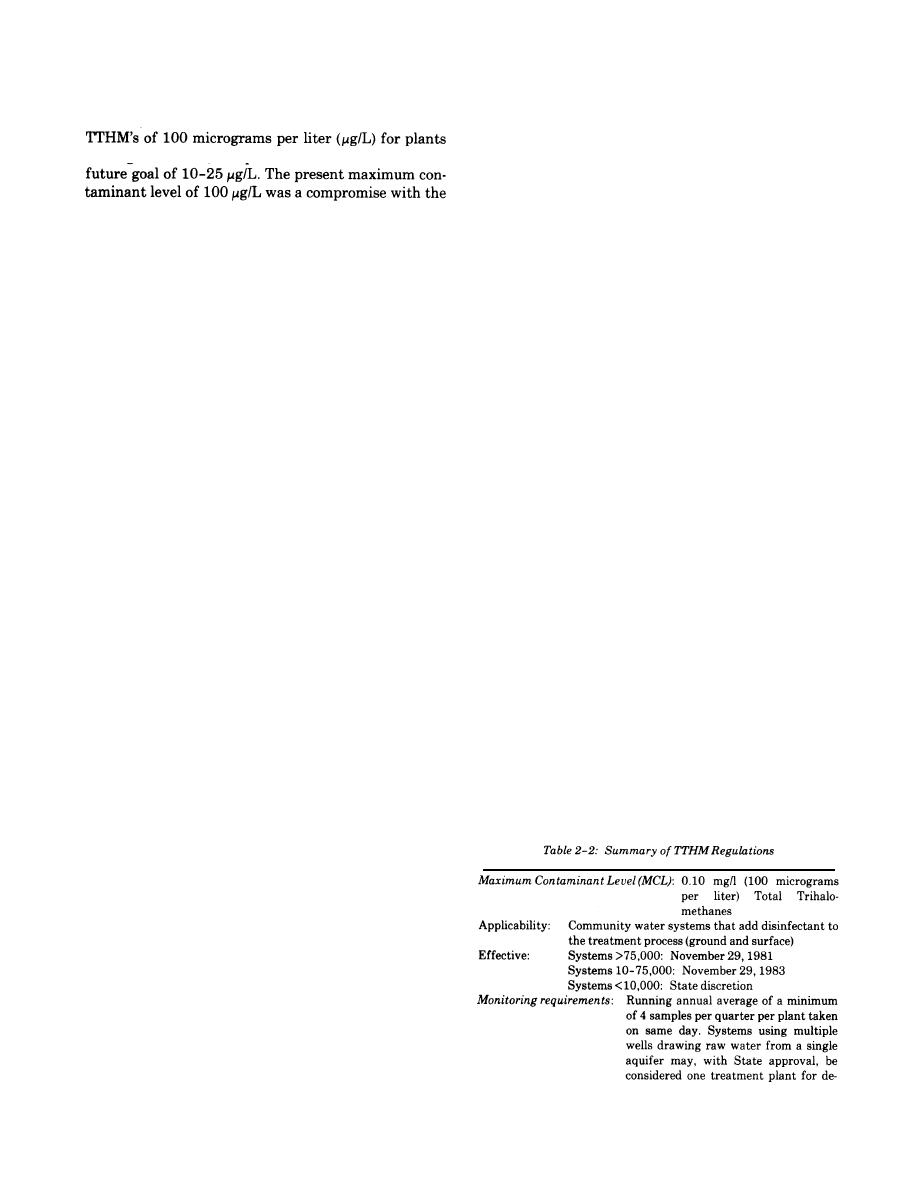
TM 5-813-3/AFM 88-10, Vol 3
compounds, e.g., trihalomethanes (see para 2- 13.b.).
may later be desirable for improving treatment or dis-
The US EPA, after much discussion over costs/
infection processes.
benefits, has chosen a maximum contaminant level for
3 Dechlorination. Dechlorination is the prac-
tice of adding chlorine to water in the distribution sys-
serving above 10,000 persons and has indicated a
tem to maintain a minimum chlorine residual through-
out the system.
(b) Chlorination equipment. Hypochlorite salts
water treatment industry to avoid costly modifications
must be applied to the water in solution form. Hypo-
to existing plants. To reach the US EPA's future maxi-
chlorite solutions are pumped by a diaphragm pump
mum contaminant level for TTHM's, more significant
through an injection system into the water to be chlo-
changes in disinfection practices will be required.
rinated. If elemental chlorine is used for disinfection,
it shall be injected by solution-type chlorinators. Since
(4) Application of chlorine. Chlorine may be ap-
chlorine solutions are acidic, many components of a
plied to water of two forms: As gaseous elemental
chlorination system must be constructed of corrosion
chlorine or as hypochlorite salts. Gaseous elemental
resistant materials such as glass, silver, rubber, or
chlorine shall be used for water disinfection at all fixed
plastics. Maintaining the chlorination apparatus in a
installations. The cost of hypochlorite salts is prohibi-
trouble-free state is essential, Key spare parts and re-
tive in all plants larger than 0.5 mgd. For remote sites
pair kits for chlorination systems must be kept on
at fixed installations, some well sources require 5 gpm
hand. Critical components of the chlorination system
or less. These sources with small demands can use
shall be installed in duplicate.
hypochlorite for disinfection.
(c) Automatic control. If automatic chlorination
(a) Point of application. Chlorine may be ap-
control is utilized, the chlorine feed rate should be con-
plied to water in a variety of locations in the water
trolled primarily by the rate of flow of water, with a
treatment plant, storage facilities, or distribution sys-
signal from a downstream residual chlorine analyzer
tem. It is absolutely essential that the chlorine applied
used to trim the feed rate. Provision for manual con-
to the water be quickly and thoroughly mixed with the
trol during emergency situations must be included.
water undergoing treatment. If required, special chlo-
(5) Superchlorination and dechlorination. Super-
rine mixing facilities should be provided. In conven-
chlorination may be necessary if there are large vari-
tional water treatment plants, chlorine may be applied
ations in chlorine demand or if available contact time
--..
prior to any other treatment process (prechlorination),
is brief. Water which has been superchlorinated gen-
following one or more of the unit treatment process
erally requires dechlorination before discharge to the
(postchlorination), and again in the more distant
distribution system. Dechlorination may be achieved
points of the distribution system (dechlorination).
through the application of sulfur dioxide, sodium bi-
1 Prechlorination., Prechlorination has often
sulfite, or sodium sulfite, or by passing the water
been used so the water would maintain a chlorine
through granular activated carbon filters. The de-
residual for the entire treatment period, thus length-
chlorination process (and subsequent dechlorination, if
ening the contact time. The coagulation, flocculation,
necessary) shall be controlled so that the free residual
and filtration processes were thought to be improved
chlorine remaining in the water is at least 0.2 mg/L.
by prechlorination of the water, and nuisance algae
Careful monitoring must be practiced to assure that
growths in settling basins were reduced. In prechlo-
potentially harmful levels of TTHMs are not exceeded.
rination, the chlorine was usually injected into the raw
A summary of TTHM regulations are presented in
water at or near the raw water intake. Prechlorination
table 2-2.
was the most accepted practice of disinfection in the
past. However, since many surface waters contain
THM precursors that will combine with the free chlo-
rine during prechlorination and form potentially car-
cinogenic THMs, such as chloroform, the point of
application has been shifted further down the treat-
ment process to take advantage of precursor removal
during treatment.
2 Postchlorination. Postchlorination general-
ly involves the application of chlorine immediately
after filtration and ahead of the clear well. The design
and construction of water treatment plants for mili-
tary installations will include the necessary provisions
for changing the locations of chlorine applications as
2-15


 Previous Page
Previous Page
